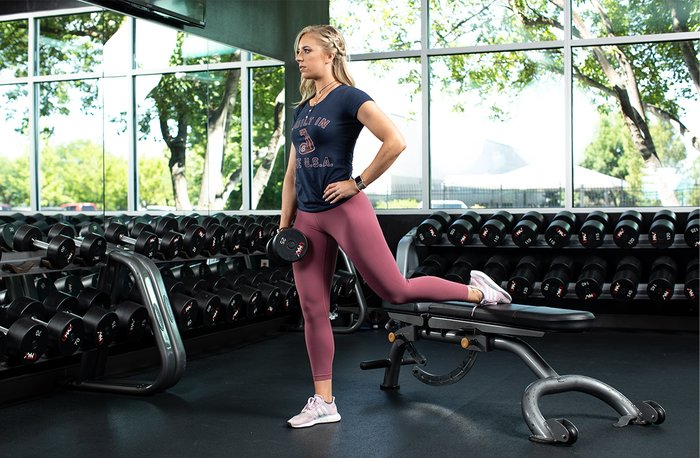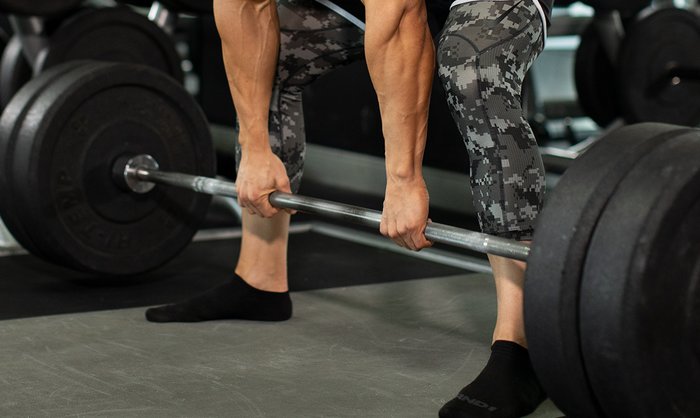The only thing I hate more than a stupid exercise is an exercise that has tons of potential value, but which frustrates a lifter’s ability to receive those benefits because of how much they struggle to get the right setup.
You may think this only applies to (for lack of a better word) “weird” exercise, but that’s far from the truth. This is an ongoing issue in the gym on plenty of popular lifts, and it causes lifters to neglect the lifts altogether instead of seeking useful hacks or variations. As an aside, it’s especially true with big and tall lifters.
That’s where I come in. These common exercises can be a hassle to work with, but these mods can help. Put them into action!
Problem 1: Single-Leg Deadlifts and Balance
Solution: Hold on to something! (Duh.)
This is a common-sense tip that many people avoid for some reason, and it’s time to stop! If you’re most concerned with using SLDLs for hamstring and glute isolation and development—which is really what they’re best at—then why are you making balance an additional thing that you have to worry about, instead of saving that skill development for another exercise? Simply lightly hold on to a solid piece of equipment like a post or counter, and you will instantly improve your form and perform better SLDLs.

Problem 2: Mixed-Grip Deadlifts and Shoulder and Arm Problems
Solution: Set your ego aside and train double overhand. Or, just use a trap bar.
A big mistake many lifters make once they get into a deadlifting groove is that of doing all of their sets of deadlifts with a mixed grip—not just the heavy singles and doubles where their grip is the limiting factor. When deadlifting with a barbell, setting up with one hand internally rotated and the other externally rotated may bolster your grip strength, but it doesn’t do much for your shoulder health under heavy loading.

It may seem like no big deal, but the number of imbalances and stresses that repeatedly practicing this can cascade through the upper body is probably not worth the risk if you’re not a competitive lifter. Plenty of lifters find it feels awful in their shoulders, and catastrophically bad in their biceps. Fun fact: In the entire time I’ve been training as a career, every single one of the ruptured biceps tendons I’ve seen occur from deadlifting (you can find them on YouTube fail videos, but be sure you have a strong stomach) have always occurred on the open side of the mixed grip. That must mean something.
Instead, I recommend riding the double overhand grip for all it’s worth. Beyond that, I like to use a simple rule: If you can’t double-overhand lift it, you can’t lift it, period. If you need to go heavier for whatever reason, sure, feel free to strap up. Or just get stronger.
Alternatively, the trap bar presents the opportunity to use a very safe, neutral grip, and a higher pulling handle. And I’ve got the best damn trap bar workout right here.
Problem 3: Running Out of Space for Sled Drags
Solution: Band it up!
These days, many gyms include the luxury of an indoor turf strip or space. It’s a great place for performance training, conditioning work, drills, and more. However, there’s one way that these fake grassy patches will always fall short of an actual patch of grass.
Say you want to do some sled drags. The issue comes when you attach straps or a TRX to the sled and start pulling backwards. Often, you’ll find you’re already halfway down the turf when the straps are fully extended, before you even take your first step. That can frustrate your desire to have a proper, full distance to travel when doing towing drills.
The solution: Make a net of bands across the handles of the prowler or sled to support your body weight for backward pushing. For most people, three bands is more than enough to do the job—at 250 pounds, that setup works just fine for me. Here’s an example of me using just that in a tight space for some conditioning work.
Problem 4: Poorly Equipped Gym for Squats
Solution: Band it up again!
Especially if you’re training in a condo or hotel gym, many times the equipment they have to offer is minimalistic at best. The dumbbells or kettlebells only go up to a halfway-decent load, and all that’s left are a couple of benches, a treadmill, and maybe a universal machine.
This spells trouble when you had the plan to train legs—and more specifically, squats. Of course, you don’t need a barbell to still get a good squat workout in. We already knew that, and I’ve written about the many virtues of both split squats and lunges in the past.
But even in the case of the goblet squat, chances are if you’ve been training for a while, a 30-pound kettlebell won’t cut it.
The best way to improve the situation would be to add a band for accommodating resistance. As you go up, the band tightens, making the top half of your squat feel drastically heavier than it did without the band. As a bonus, this will absolutely annihilate the core and postural muscles like the spinal erectors, rhomboids, and lower traps. Most of my clients also say they get a massive pump for the quads, and I concur.
Don’t try to be a hero; if you think the thick green or blue band is what you need for this, you’re wrong. Start skinny and build from there. The band being used in the video is more than enough added resistance to a 40-pound kettlebell and can make for a solid workout.
Problem 5: Pull-ups and Presses and Elbow Pain
Solution: Stop back squatting.
The problem and the solution here may seem unrelated, but trust me on this one. Medial epicondylitis (golfer’s elbow) creates pain and discomfort on the inside of the elbow, closest to the torso. It can be very annoying and get in the way of many upper-body lifts including basic presses and chin-ups. For many lifters, it means extensive rest time to avoid flare-ups.
But it’s important to remember that the elbow’s health is directly contingent upon the health of the shoulder—just like the relationship between the knee and the hip joints. A silent killer to elbow health can indeed be back squats when a lifter has insufficient shoulder mobility. Rather than put this in writing, use this video explanation for a visual demo.
Changing things up to a front squat, safety bar squat, or even those banded goblets can act as the saving grace to make a huge impact in curing cranky elbows. And it’s a fix that not many people think of. Try it and thank me later.
The best lifts are even better with the right coaching. Get game-changing cues along with periodized programming in True Muscle: 9 Weeks to Elite Fitness, only in Bodybuilding.com BodyFit.
